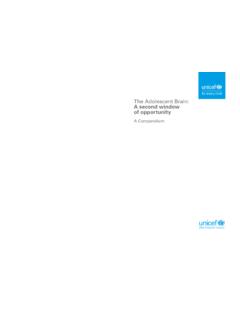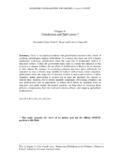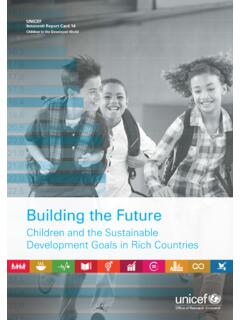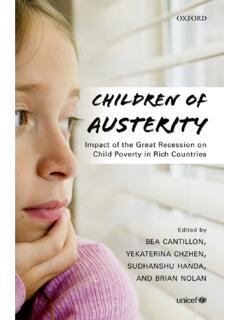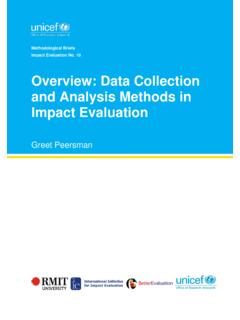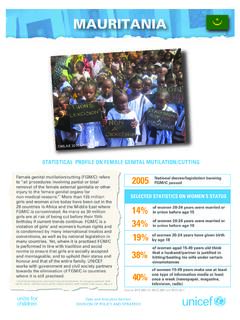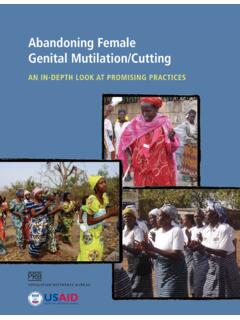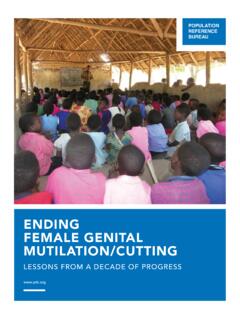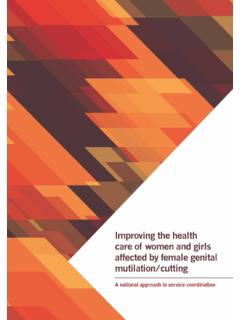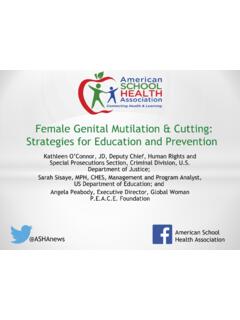Transcription of FEMALE GENITAL MUTILATION/CUTTING - UNICEF-IRC
1 Innocenti DigestCHANGING A HARMFULSOCIAL CONVENTION: FEMALE GENITALMUTILATION/CUTTINGUNICEFI nnocenti Research CentreInnocenti DigestCHANGING A HARMFULSOCIAL CONVENTION: FEMALE GENITAL mutilation /CUTTINGiiInnocenti DigestEditor: Alexia LewnesFront cover picture: UNICEF/MENA/2004/1301/Ellen GruenbaumLayout: Bernard & Co, Siena, ItalyPrinted by ABC Tipografia, Sesto Fiorentino, Italy 2005 United Nations Children s Fund (UNICEF)ISBN: 88-89129-24-7 ISSN: 1028-3528 Reprinted in May 2008 The opinions expressed are those of the authors and editorsand do not necessarily reflect the policies or views of UNICEF. iiiInnocenti DigestAcknowledgmentsUNICEF Innocenti Research Centre in Florence, Italy, was established in 1988 to strengthen the research capa-bility of the United Nations Children Fund and to support its advocacy for children worldwide.
2 The Centre (for-mally known as the International Child Development Centre) helps to identify and research current and futureareas of UNICEF s work. Its prime objectives are to improve international understanding of issues relating tochildren s rights and to help facilitate the full implementation of the United Nations Convention on the Rights ofthe Child in both industrialized and developing countries. The Innocenti Digests are produced by the Centre toprovide reliable and accessible information on specific rights issue of the Innocenti Digesthas been principally researched and written by Michael Miller and FrancescaMoneti with additional research contributions by Camilla Landini. It was prepared under the guidance of the Cen-tre s Director, Marta Santos Pais.
3 Administrative support was provided by Claire Akehurst. The Communication andPartnership Unit are thanked for moving this document through the production process. Special thanks to Samira Ahmed, Farida Ali, Daniela Colombo, Maria Gabriella De Vita, Malik Diagne, NeilFord, Gerry Mackie, Molly Melching, Rada Noeva, Cristiana Scoppa, Mamadou Wane and Stan Yoder for theirexpert contribution, support and counsel publication has benefited from the input of participants in the consultation on FGM/C held at UNICEFI nnocenti Research Centre in October 2004. These include Zewdie Abegaz, Heli Bathija, Nafissatou Diop, AmnaHassan, Khady Koita, Edilberto Loaiza, Diye Ndiaye, Eiman Sharief and Nadra Zaki. It was also enriched by inputfrom the technical meeting on FGM/C, organized by UNICEF New York Child Protection Section and hosted byUNICEF IRC in October Innocenti Research Centre is grateful to the Dutch, Spanish and Swiss National Committees forUNICEF for additional information, and to UNICEF country and regional offices in Eastern and Southern Africa,Middle East and North Africa, and West and Central Africa for their input and Innocenti Research Centre gratefully acknowledges the financial support provided to the Centreand specifically for this project by the Government of Italy as well as the financial contribution provided by theGovernment of Japan.
4 Previous Digest titles include:_ Ombudswork for Children_ Children and Violence_ Juvenile Justice_ Intercountry Adoption_ Child Domestic Work_ Domestic Violence against Women and Girls_ Early Marriage: Child Spouses_ Independent Institutions Protecting Children s Rights_ Birth Registration: Right from the Start_ Poverty and Exclusion among Urban Children_ Ensuring the Rights of Indigenous ChildrenFor further information and to download these and other publications, please visit the website or, to order publications, contact Centre s publications are contributions to a global debate on child rights issues and include a wide rangeof opinions. For that reason, the Centre may produce publications that do not necessarily reflect UNICEF poli-cies or approaches on some topics.
5 The views expressed are those of the authors and are published by the Cen-tre in order to stimulate further dialogue on child rights. Extracts from this publication may be freely reproduced, provided that due acknowledgement is given to thesource and to UNICEF. The Centre invites comments on the content and layout of the Digest and suggestions onhow it could be improved as an information correspondence should be addressed to:UNICEF Innocenti Research CentrePiazza SS. Annunziata, 1250122 Florence, ItalyTel: (+39) 055 20 330 Fax: (+39) 055 20 33 220 Email general: publication orders: (downloadable version of this report is available online)Mona Omar, social worker in an awareness raising session on FGM, holding a poster that says from the medical per-spective, FGM is the most harmful practice.
6 Nazlet Ebeed district in Menya, Upper Egypt at Better Life Association UNICEF/Egypt/2005/838/PirozzivInnocenti DigestTABLE OF CONTENTSF oreword ..vii1. Introduction ..1 What is FGM/C?2. Magnitude, Assessment and Measurement ..3 Where is FGM/C practiced? ..3 Disaggregated data ..5 The circumstances surrounding FGM/C ..6 FGM/C and changes over time ..7 Standardizing indicators for situation analysis and monitoring progress ..83. The Social Dynamics of FGM/C ..11 Mechanisms that reinforce the social convention ..11 Changing the social convention: towards the abandonment of FGM/C ..13 Abandoning FGM/C: six key elements for change ..134. FGM/C and Human Rights ..15 FGM/C and the rights of the child ..15 Best interests of the child and the right of the child to respect for his or her views.
7 15 The rights to life and to the highest attainable standard of health ..16 Freedom from physical or mental violence, injury or abuse ..18 State obligations ..185. Community-based Actions ..23 Changing the social convention: from theory to practice ..23 Facilitating dialogue and non-judgmental discussion ..25 Alternative rites of passage ..26 Alternative employment opportunities for traditional excisers ..26 Working with migrant communities in industrialised countries ..276. Creating an Enabling Environment for Change ..29 National legislation ..29 Regional standards ..30 Raising awareness and promoting dialogue ..31 Integrating the abandonment of FGM/C in government programmes ..31 Coordinating actions ..327. Conclusions.
8 35 Links ..37 BOXESBox 1 - Classification of FGM/C types ..2 Box 2 - Demographic and Health Surveys and Multiple Indicator Cluster Surveys ..5 Box 3 - FGM/C and footbinding: a path to marriage and improved social status ..12 Box 4 - Statements from Islamic and Coptic church leaders ..12 Box 5 - A mother s story: Challenges faced by those who begin the process of change ..13 Box 6 - The emergence of FGM/C as a human rights issue ..16 Box 7 - The trend towards medicalization and symbolic interventions ..17 Box 8 - Some recent concluding observations from the Committee on the Rights of the Child regarding FGM/C ..19 Box 9 - Organized diffusion begins in Senegal ..24 Box 10 - Communication for social change ..25 Box 11 - Nantoondiral: using film to stimulate discussion.
9 26 Box 12 - Legal responses to FGM/C in Western Europe ..30 Box 13 - TAMWA media campaigns in Tanzania ..31 Box 14 - The United Nations increasing engagement with FGM/C and other harmful traditional practices ..33 MAPSMap 1 Countries in which FGM/C is practiced ..4 Map 2 Central African Republic, 2000 ..5 TABLET able 1 - FGM/C prevalence among women aged 15 to 49 by country ..4 Table 2 - Prevalence (per cent) of FGM/C among daughters, by mother s education ..6 Table 3 - FGM/C prevalence in countries where two DHS surveys have been conducted ..7viInnocenti DigestviiInnocenti DigestEvery year, three million girls and women are sub-jected to GENITAL MUTILATION/CUTTING , a dangerous andpotentially life-threatening procedure that causesunspeakable pain and suffering.
10 This practice violatesgirls and women s basic human rights, denyingthem of their physical and mental integrity, their rightto freedom from violence and discrimination, and inthe most extreme case, of their life. FEMALE GENITAL MUTILATION/CUTTING (FGM/C) is aglobal concern. Not only is it practiced among com-munities in Africa and the Middle East, but also inimmigrant communities throughout the world. More-over, recent data reveal that it occurs on a much larg-er scale than previously thought. It continues to beone of the most persistent, pervasive and silentlyendured human rights violations. This Innocenti Digestexamines the social dynam-ics of FGM/C. In communities where it is practiced,FGM/C is an important part of girls and women s cul-tural gender identity.

